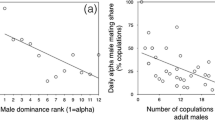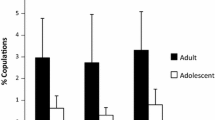Abstract
The common chimpanzee has been considered to be a promiscuous species, although transient consort relationships and male possessive behavior have been described byTutin (1975, 1979).
A prolific adult male chimpanzee was housed with from four to seven adult female chimpanzees (depending on the females' maternal status) and copulations were recorded from August 7, 1978 until February 16, 1979, during morning feeding periods. Ten females composed the fluctuating available partners.
Sixty-four observed copulations involved six females. One female was clearly preferred, including occasions when she was not maximally tumescent (e.g., completely detumescent, pregnant) and other available females were maximally tumescent. The remainder of the observed copulations, with one exception, involved females who had recently been reintroduced into the one-male breeding group. Such copulations took place on and continued temporarily after the day of reintroduction for two females, and after the resumption of menstrual cycling for two females who had been reintroduced while still lactating. Nonpreferred females were impregnated during the period of data collection, even though copulations with them were not observed.
These data suggest that the male chimpanzee can form an individual mating preference regardless of the hormonal status of his available partners without lessening his reproductive success with nonpreferred females, but also tends toward maximization of his reproductive success by copulating with novel females.
Similar content being viewed by others
References
Agar, M. E. &G. Mitchell, 1975. Behavior of free-ranging rhesus macaques: a review. In:The Rhesus Monkey, Vol. 1,G. H. Bourne (ed.), Academic Press, New York, pp. 323–342.
Allen, M. L. & W. B. Lemmon, in press. Orgasm in female primates.Amer. J. Primatol.
Ball, J., 1941. Effect of progesterone on sexual excitability in the female monkey.Psychol. Bull., 38: 533–534.
Beach, F. A., 1976a. Hormonal control of sex-related behavior. In:Human Sexuality in Four Perspectives,F. A. Beach (ed.), Johns Hopkins Univ. Press, Baltimore, pp. 247–267.
————, 1976b. Sexual attractivity, proceptivity and receptivity in female mammals.Horm. Behav., 7: 105–138.
Coe, C. L., A. C. Connolly, H. C. Kraemer &S. Levine, 1979. Reproductive development and behavior of captive female chimpanzees.Primates, 20: 571–582.
Dixson, A. F., B. J. Everitt, J. Herbert, S. M. Rugman &D. M. Scruton, 1973. Hormonal and other determinants of sexual attractiveness and receptivity in rhesus and talapoin monkeys.Proc. Symp. 4th Int. Cong. Primatol. Vol. 2,E. W. Menzel (ed.), S. Karger, Basel, pp. 36–63.
Eaton, G. G. &J. A. Resko, 1974. Ovarian hormones and sexual behavior inMacaca nemestrina.J. Comp. Physiol. Psychol., 86: 919–925.
Enomoto, T., 1974. The sexual behavior of Japanese monkeys.J. Human Evol., 3: 351–372.
————, 1978. On social preference in sexual behavior in Japanese monkeys (Macaca fuscata).J. Human Evol., 7: 283–293.
Everitt, B. J. &J. Herbert, 1969. The role of ovarian hormones in the sexual behavior of rhesus monkeys.Anim. Behav., 17: 738–746.
Ford, C. S. &F. A. Beach, 1951.Patterns of Sexual Behavior. Harper & Row, New York.
Fox, C. A. &B. Fox, 1971. A comparative study of coital physiology, with special reference to the sexual climax.J. Reprod. Fertil., 24: 319–336.
Goldfoot, D. A., 1971. Hormonal and social determinants of sexual behavior in pigtail monkeys (Macaca nemestrina). In:Normal and Abnormal Development of Brain and Behavior,G. B. A. Stoelinga &J. J. van der Werff ten Bosch (eds.), Leiden Univ. Press, Leiden, pp. 325–341.
Goodall, J., 1965. Chimpanzees of the Gombe Stream. In:Primate Behavior,I. DeVore (ed.), Holt, Rinehart & Winston, New York, pp. 425–473.
Graham, C. E., 1970. Reproductive physiology of the chimpanzee. In:The Chimpanzee, Vol. 3,G. H. Bourne (ed.), S. Karger, Basel, pp. 183–220.
————, 1973. Chimpanzee endometrium and sexual swelling during menstrual cycle or hormone administration.Folia Primatol., 19: 458–468.
————, 1976. The chimpanzee: a unique model for human reproduction. In:The Laboratory Animal in the Study of Reproduction,Th. Antikalzides,I. Ericksen &A. Spiegel (eds.), Gustv, Fischer Verlag, New York, pp. 29–38.
————,D. C. Collins, H. Robinson &J. R. K. Preedy, 1972. Urinary levels of estrogens and pregnanediol and plasma levels of progesterone during the menstrual cycle of the chimpanzee: relationship to the sexual swelling.Endocrinology, 91: 13–24.
Hausfater, G., 1975.Dominance and Reproduction in Baboons (Papio cynocephalus). Contributions to Primatology, Vol. 7, S. Karger, Basel.
Hays, W. L., 1973.Statistics for the Social Sciences. Holt, Rinehart & Winston, New York.
Herbert, J., 1968. Sexual preference in the rhesus monkeyMacaca mulatta in the laboratory.Anim. Behav., 16: 120–128.
————, 1978. Neurohormonal integration of sexual behaviour in female primates. In:Biological Determinants of Sexual Behaviour,J. B. Hutchison (ed.), John Wiley & Sons, New York, pp. 467–491.
Hess, J. P., 1973. Some observations on the sexual behavior of captive lowland gorillas,Gorilla g. gorilla (Savage andWyman). In:Comparative Ecology and Behaviour of Primates,R. P. Michael &J. H. Crook (eds.), Academic Press, New York, pp. 508–581.
Hobson, W., F. Coulson, C. Faiman, J. S. D. Winter, &F. Reyes, 1976. Reproductive endocrinology of the female chimpanzee: a suitable model for humans.J. Toxicol. Environ. Health, 1: 657–668.
Kinsey, A. C., W. B. Pomeroy, C. E. Martin &P. H. Gebhard, 1953.Sexual Behavior in the Human Female. W. B. Saunders, Philadelphia.
Kortlandt, A., 1962. Chimpanzees in the wild.Sci. Amer., 206: 128–138.
Kummer, H., 1971.Primate Societies: Group Techniques of Ecological Adaptation. Aldine, New York.
Lancaster, J. B., 1979. Sex and gender in evolutionary perspective. In:Human Sexuality,H. A. Katchadourian (ed.), Univ. of California Press, Berkeley, pp. 51–80.
Lawick-Goodall, J. van, 1975. The behaviour of the chimpanzee. In:Hominization and Verhalten,I. Eibl-Eibesfeldt (ed.), Gustav, Fischer Verlag, New York, pp. 56–100.
Lemmon, W. B. &M. L. Allen, 1978. Continual sexual receptivity in the female chimpanzee (Pan troglodytes).Folia Primatol., 30: 80–88.
McGinnis, P. R., 1973. Patterns of sexual behavior in a community of free-living chimpanzees. Ph. D. Thesis, Univ. of Cambridge, Cambridge.
Michael, R. P., 1968. Gonadal hormones and the control of primate behavior. In:Endocrinology and Human Behavior,R. P. Michael (ed.), Oxford Univ. Press., New York, pp. 69–93.
————,E. B. Keverne &R. W. Bonsall, 1971. Pheromones: isolation of male sex attractants from a female primate.Science, 172: 964–966.
————,D. Zumpe, E. B. Keverne &R. W. Bonsall, 1972. Neuroendocrine factors in the control of primate behavior.Rec. Prog. Horm. Res., 28: 665–706.
Money, J., 1961. Sex hormones and other variables in human eroticism. In:Sex and Internal Secretions, Vol. 2,W. C. Young (ed.), Williams & Wilkins, Baltimore, pp. 1383–1400.
————,J. G. Hampson &J. L. Hampson, 1957. Imprinting and the establishment of gender role.A. M. A. Arch. Neurol. Psychiat., 77: 333–336.
Nishida, T., 1968. The social group of wild chimpanzees in the Mahali Mountains.Primates, 9: 167–224.
————, 1979. The structure of chimpanzees of the Mahali Mountains. In:The Great Apes. Perspectives on Human Evolution, Vol. 5,D. A. Hamburg &E. R. McCown (eds.), Benjamin & Cummings, Menlo Park, California, pp. 73–121.
Perachio, A. A., M. Alexander &L. D. Marr, 1973. Hormonal and social factors affecting evoked sexual behavior in rhesus monkeys.Amer. J. Phys. Anthropol., 38: 227–232.
Phoenix, C. H., 1973. Ejaculation by male rhesus as a function of the female partner.Horm. Behav., 4: 365–370.
Pusey, A., 1979. Inter-community transfer of chimpanzees in the Gombe National Park. In:The Great Apes. Perspectives on Human Evolution, Vol. 5,D. A. Hamburg &E. R. McCown (eds.), Benjamin & Cummings, Menlo Park, California, pp. 465–479.
Rowell, T. E., 1963. Behaviour and female reproductive cycles of rhesus macaques.J. Reprod. Fertil., 6: 193–203.
Saayman, G. S., 1970. The menstrual cycle and sexual behavior in a troop of free-ranging chacma baboons (Papio ursinus).Folia Primatol., 12: 81–110.
————, 1972. Effects of ovarian hormones upon the sexual skin and mounting behavior in the free-ranging chacma baboon (Papio ursinus).Folia Primatol., 17: 297–303.
Slob, A. K., M. J. Baum &P. E. Schenck, 1978. Effects of the menstrual cycle, social grouping, and exogenous progesterone on the heterosexual interaction in laboratory housed stumptail macaques (Macaca arctoides).Physiol. Behav., 21: 915–921.
————,S. J. Wiegand, R. W. Goy &J. A. Robinson, 1978. Heterosexual interactions in laboratory-housed stumptail macaques (Macaca arctoides): observations during the menstrual cycle and after ovariectomy.Horm. Behav., 10: 193–211.
Stephenson, G. R., 1975. Social structure of mating activity in Japanese macaques.Proc. Symp. 5th Congr. Int. Primatol. Soc.,S. Kondo,M. Kawai,A. Ehara &A. Ehara &S. Kawamura (eds.), Japanese Science Press, Tokyo, pp. 63–115.
Tutin, C. E. G., 1975. Exceptions to promiscuity in a feral chimpanzee community. In:Contemporary Primatology,S. Kondo,M. Kawai &A. Ehara (eds.), S. Karger, Basel, pp. 445–449.
————. 1979. Mating patterns and reproductive strategies in a community of wild chimpanzees (Pan troglodytes schweinfurthii).Behav. Ecol. Sociobiol., 6: 29–38.
----, &P. R. McGinnis, in press. Reproduction of the chimpanzee in the wild. In:Reproductive Biology of the Great Apes,C. E. Graham (ed.), Academic Press, New York.
Wickler, W., 1967. Socio-sexual signals and their intraspecific imitation among primates. In:Primate Ethology,D. Morris (ed.), Weidenfeld & Nicholson, London, pp. 69–147.
Wolfe, L., 1979. Behavioral patterns of estrous females of the Arashiyama West troop of Japanese macaques (Macaca fuscata).Primates, 20: 525–534.
Wrangham, R. W., 1979. Sex differences in chimpanzee dispersion. In:The Great Apes. Perspectives on Human Evolution, Vol. 5,D. A. Hamburg &E. R. McCown (eds.), Benjamin & Cummings, Menlo Park, California, pp. 481–489.
Young, W. C., 1961. The hormones and mating behavior. In:Sex and Internal Secretions, Vol. 2,W. C. Young (ed.), Williams & Wilkins, Baltimore, pp. 1173–1239.
———— &W. D. Orbison, 1944. Changes in selected features of behavior in pairs of oppositely sexed chimpanzees during the sexual cycle and after ovariectomy.J. Comp. Physiol. Psychol., 37: 107–143.
Author information
Authors and Affiliations
About this article
Cite this article
Allen, M. Individual copulatory preference and the “strange female effect” in a captive group-living male chimpanzee (Pan troglodytes). Primates 22, 221–236 (1981). https://doi.org/10.1007/BF02382612
Received:
Accepted:
Issue Date:
DOI: https://doi.org/10.1007/BF02382612




